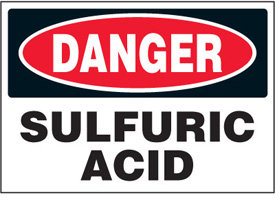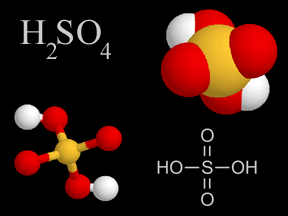
by Bailiff Enterprises

Sulfuric Acid (H2SO4) |
||
| ..... | Sulfuric Acid is sometimes call the universal chemical. This is due to the wide number of processes it is used in and products it produces. It is also sometimes known as Sulphuric Acid. |
|
| There is more than one way to produce Sulfuric Acid. One of the most widely used commercially is through the combustion of elemental sulfur. That forms sulfur dioxide which is then changed into sulfur trioxide via catalytic oxidation. Once the sulfur trioxide (SO3) is produced, it reacts as water is absorbed and the result is concentrated sulfuric acid. | ||
| Sulfuric Acid is widely used in industry for several reasons. It has relatively low cost and has low volatility. Sulfuric Acid is able to act as a strong oxidizing agent as well as a strong dehydrating agent. Finally, Sulfuric Acid has very strong acidic properties. | ||
| The best way to give you excellent and reliable information about Sulfuric Acid Safety is to give you the following link. It is to the information on Sulfuric Acid from the National Institute for Occupational Safety and Health. They are a part of the US Center for Disease Control (CDC). Click here for their information about Sulfuric Acid Safety. | ||
| Sulfuric Acid in the US is produced by a surprisingly large number of companies. They mostly have regional coverage. Sulfuric Acid is sold in high purity solutions ranging from 93% to 97% concentration. It is also sold in more dilute solutions of less than 50% concentrations. | ||
| Storage of Sulfuric Acid requires special consideration. Especially in high purity form it is an aggressive chemical that attacks most bulk storage containers. Concentrated Sulfuric Acid weighs nearly twice as much as water per gallon. It is corrosive to metals and an oxidizer of plastics. To further complicate the storage challenge, an exothermic reaction takes place when sulfuric acid comes in contact with water. The heat that is generated can severely affect storage vessels. | ||
| When storing Sulfuric Acid with concentrations of 80% or above, we suggest plastic tanks of high density polyethylene (HDPE) rated to a specific gravity of 2.2. Crosslink Polyethylene (XLPE) is not as resistant to attack by Sulfuric Acid according to research done by Exxon. Companies that produce XLPE tanks find they need go through the extra step of adding an HDPE or linear polyethylene liner to their tanks. (Occasionally you may find a reference to tanks made with HDLPE but that is just a slang term for HDPE. You can find details about HDLPE here.) Details about the recommended fitting materials for high purity Sulfuric Acid can be found by clicking here. | ||
| Sulfuric Acid solutions with concentrations of less than 80% can be stored in HDPE tanks rated to 1.9 specific gravity. Details about the recommended fitting materials for lower concentrations of Sulfuric Acid can be found by clicking here. | ||
| Sulfuric Acid should never be mixed with or diluted with water in a plastic tank. The heat given off by the resulting exothermic reaction can severely damage the storage container. | ||
| Sulfuric Acid is always best stored in double wall tanks or with secondary containment basins. Given the agressive, corrosive nature of Sulfuric Acid and the health risks it poses, you do not want to take a chance of an uncontained spill. | ||


